The next-gen MacBook Pro with Retina Display Review
by Anand Lal Shimpi on June 23, 2012 4:14 AM EST- Posted in
- Mac
- Apple
- MacBook Pro
- Laptops
- Notebooks
The King of All Notebook Displays
For years Apple has been shipping some of the best displays in consumer notebooks, but the MacBook Pro’s Retina Display is in a league of its own. While I never liked the phrase “painted on” in reference to the iPad and iPhone Retina Displays, that’s the best way I can describe the effect the MacBook Pro’s Retina Display has on me. Text really does look painted on. The effect is really the result of two things.
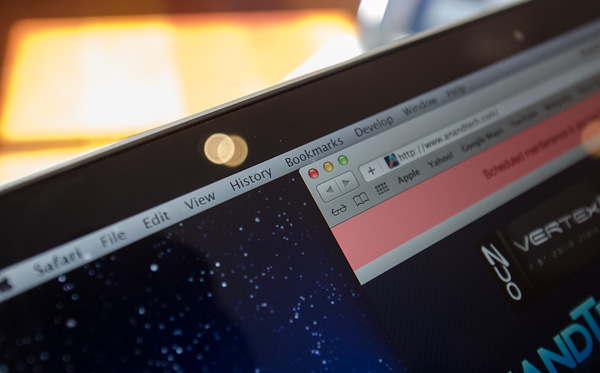
The first is Apple’s removal of its cover glass. LCD panels aren’t particularly attractive, they are ugly squares composed of two pieces of glass and a number of filters/polarizers. To hide the ugly edges, display makers wrap bezels around the display. Most people aren’t fond of bezels so next came a ton of effort to minimize bezel size. An alternative is to simply place a third piece of glass over the entire LCD assembly and make it look as if the bezel and LCD panel are integrated. This outermost layer is known as a cover glass and is what Apple uses on all of its glossy displays. If you’ve ever taken apart a Cinema/Thunderbolt Display or a newer iMac you’ll know that the cover glass is literally just a piece of glass that you have to remove with some suction cups.
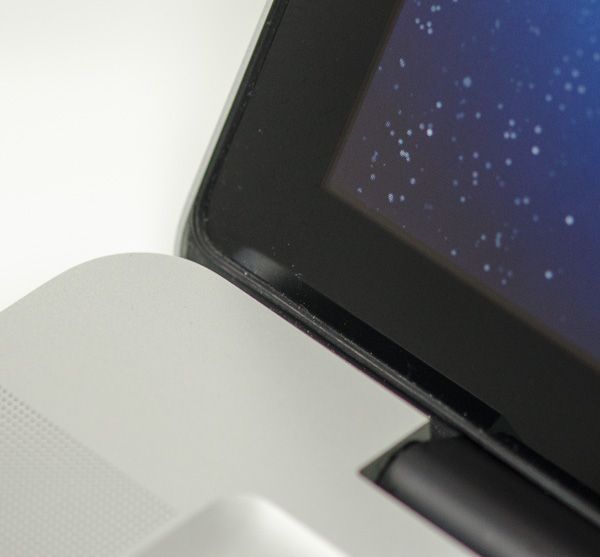
Non-Retina MacBook Pro, notice the gap between the outermost LCD glass and the cover glass
The MacBook Pro’s Retina Display does away with the cover glass and instead uses a fairly unique LCD assembly. There are still two pieces of glass but the outermost glass is actually a different size and shape - it integrates a bezel. By integrating the bezel into the outermost glass in the LCD stack you get the same effect as a cover glass but without the added reflections it introduces.
You also limit the possibility of dust getting trapped between the cover glass and the LCD. The danger is that you no longer have a protective piece of glass in front of your expensive new LCD. If you scratch the display you're scratching the LCD itself. While this has been true for conventional matte displays for a while, it's worth mentioning if you're used to Apple's glossy displays where you did have that added security layer.
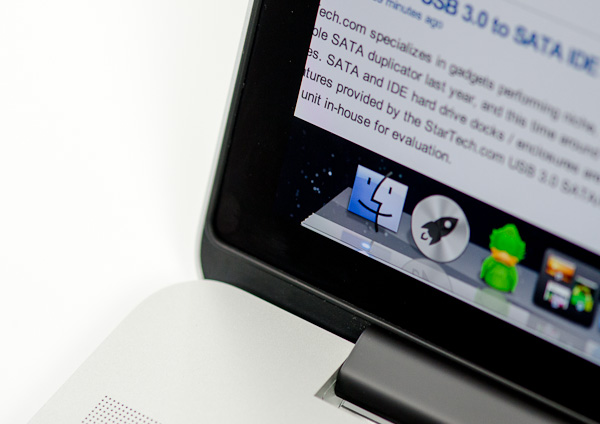
The MacBook Pro with Retina Display, no gap, no cover glass
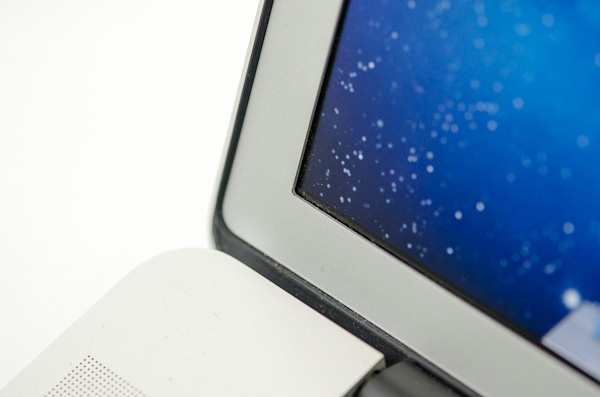
The 2011 MacBook Pro with High-Res Matte display option, no cover glass, top bezel

From left to right: 2010 High Res Glossy MBP, 2012 rMBP, 2011 High Res Matte MBP
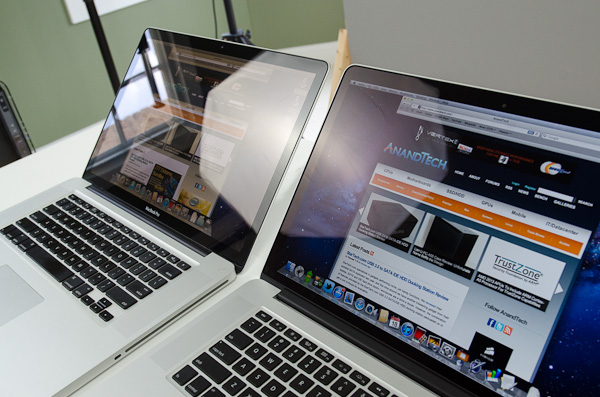
Glare handling indoors - 2011 High Res, Glossy MBP (left) vs 2012 rMBP (right)
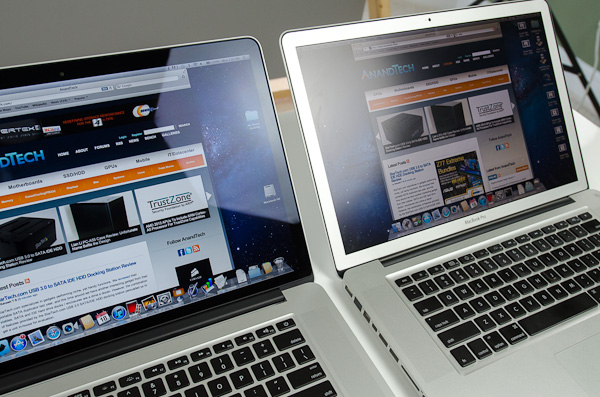
Glare handling indoors - 2012 rMBP (left) vs. 2011 High Res, Matte MBP (right)
The Retina Display is also obviously an extremely high resolution panel at 2880 x 1800. Note that this is 44.6% more pixels than Apple’s 27-inch Thunderbolt Display, and 26.6% more pixels than the 30-inch panels that we’ve loved for so long - all in a 15.4-inch notebook display.
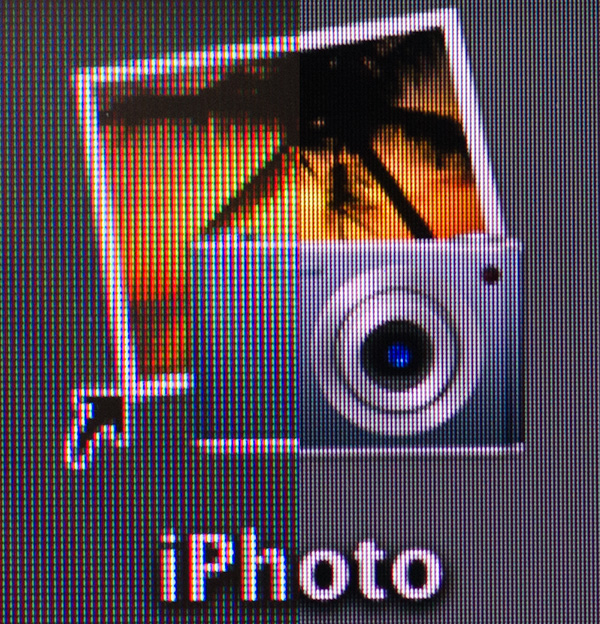
An iPhoto shortcut, High Res 2011 MBP (left) vs. Retina Display MBP (right)
At 220 pixels per inch it’s easily the highest density consumer notebook panel shipping today. At normal viewing distances and even with my face closer than I’m comfortable putting it I simply cannot discern individual pixels.
It’s the combination of these two elements, the removal of the cover glass and the insanely high pixel density that makes everything from text to UI elements just look painted on the new Retina Display. And the effect is gorgeous. I’ve never seen a prettier panel and it’s actually ruined me for pretty much all other displays, notebook and desktop.
While I can appreciate the iPad’s Retina Display, the impact from the MacBook Pro’s display is even more significant. Perhaps it’s because I still spend so much time working on a standard, non-tablet display, but I’m far more excited about this display than anything else Apple has delivered under the Retina moniker.
It’s not just pixel density that Apple has to offer here. Similar to its Retina Displays in the iPhone and iPad, the MacBook Pro’s Retina panel ditches TN in favor of IPS technology. The result is an incredible improvement in viewing angles. On a notebook I don’t spend a lot of time viewing it from far left/right angles, although I see the benefit when I’ve got others huddled around my display. Here the panel performs admirably - you lose brightness at far left/right angles but there’s no perceivable color shift. In fact, the painted on effect is even more impressive at these far left/right viewing angles.
For a single user however the more impressive characteristic is just how good the display looks at vertically off-center angles. I wrote much of the initial parts of this review while on an airplane in coach, which with a 15-inch notebook on my lap means I’m going to be looking at the display at a weird angle to begin with. The thinner rMBP doesn’t do enough to make the airplane usage model any better if the person in front of you decides to recline, but the IPS panel does make the display perfectly usable at the off-center angle you’ll inevitably have to deal with.
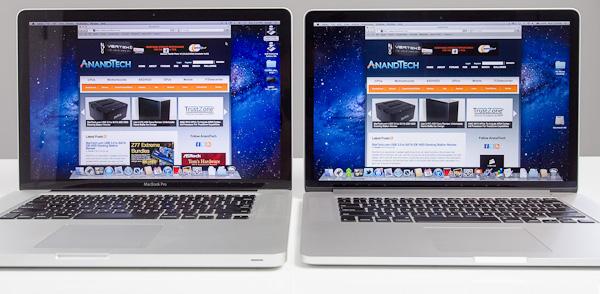
2010 High Res, Glossy MBP (left) vs. 2012 rMBP (right)
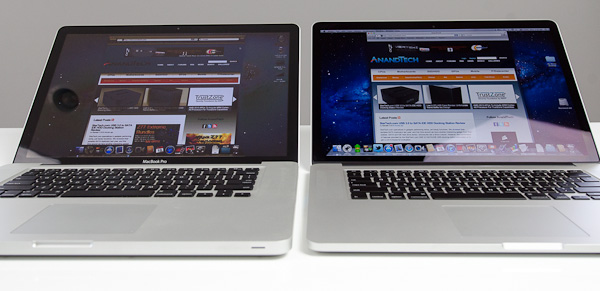
Hello colorshift!
2010 High Res, Glossy MBP (left) vs. 2012 rMBP (right)


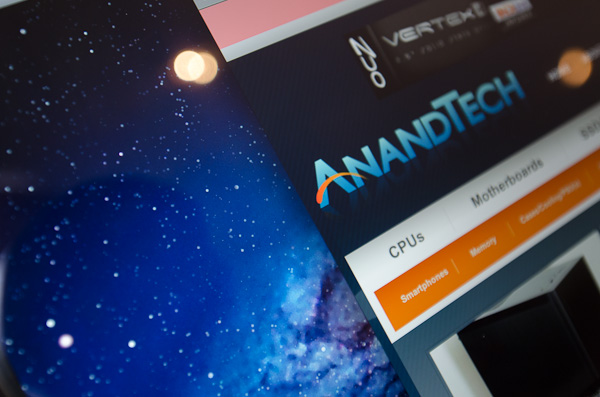
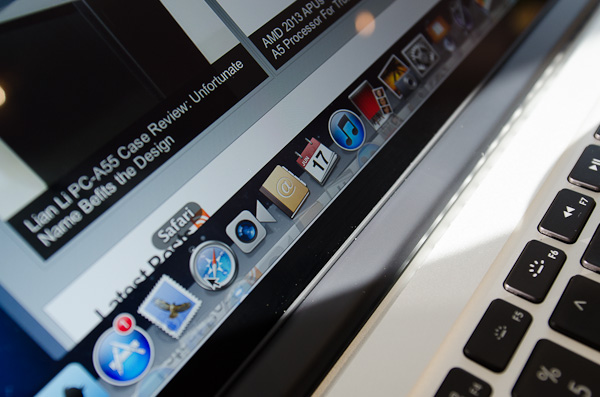
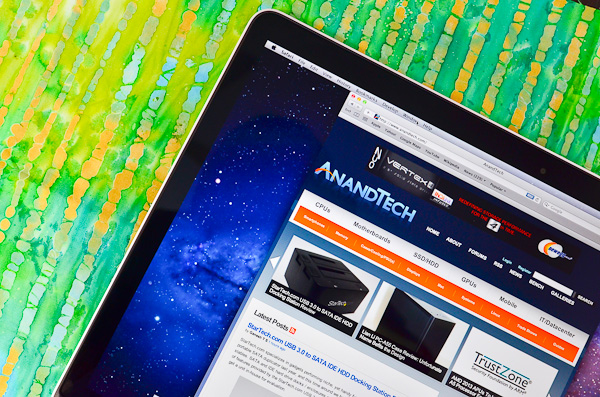
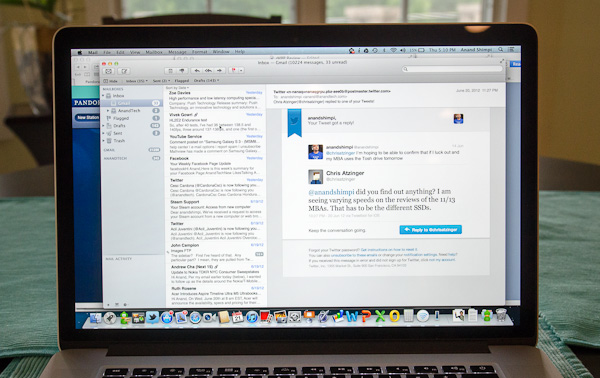
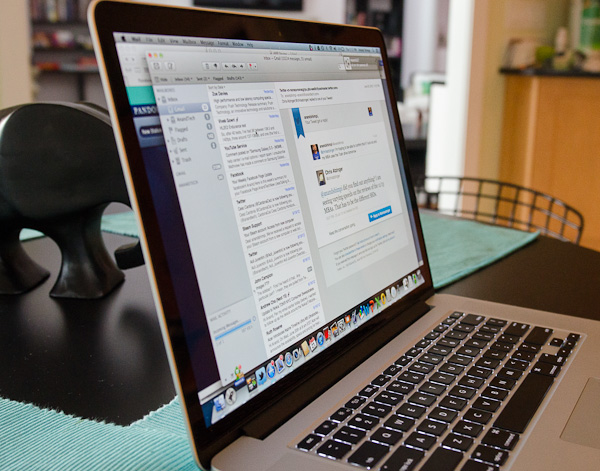








471 Comments
View All Comments
DJTryHard - Saturday, June 23, 2012 - link
No one said it was quad, this is in 2010. Arrandale had higher thermals, and today's version does have quad.OCedHrt - Sunday, June 24, 2012 - link
Not quad core. Quad raid. As in, 4 separate custom SSD boards connected to 4 separate SATA ports in raid 0. This was before there was 500mb/s raid from SF. Now it's kinda a marketing gimmick because they're not 4 500 mb/s raid that gives you nearly 2 gb/s in raid 0.Totally - Tuesday, June 26, 2012 - link
learn to readquoting op
"...fastest of the dual core i7's while..."
no one mentions anything about a quad core cpu
hkatz - Wednesday, July 11, 2012 - link
I looked up the current model. Vaio Z: 13 inch display 1920 by 1080, maximum 8 gigs ram, 512 ssd, quad core i7 2.1/3.1 , USB 3. However, no thunderbolt, only integrated graphics and the price for the 13 inch computer as above is $2999.Does not compare to the retina macbook pro which has a higher resolution 15 inch display, thunderbolt, significantly faster processor, and discrete graphics with a gig of vram. The price for the better retina macbook pro with the 512 gig flash drive is $2799.
There is no comparison.
wfolta - Saturday, June 23, 2012 - link
The Sony you linked to doesn't have discrete graphics. You have to buy (and use) the docking station to get that.If you load it up with 8 GB of RAM (which is the max, while the rMBP goes to 16 GB), a 256 GB SSD, a 10% slower CPU (2.1 versus 2.3 GHz), no discrete graphics, and a "HD" non-IPS display, it costs you $1,950 versus the rMPB's $2,200.
For the price Sony charges for the upgrade to 512 GB of SSD ($600), you can upgrade the rMBP, to a 512 GB SSD and get a 20% faster (2.6 GHz) CPU thrown in as well.
The non-IPS display means that even if the rMBP didn't have incredibly more pixels, it would still outclass the Sony display in terms of contrast, viewing angle, etc.
The Sony weights about half of what the rMBP does, but it also has less battery life and it's about the same size. I guess the VGA and ethernet ports are a big deal for you, though of course you don't get two Thunderbolt ports. Oh yeah, you also get a Sony MemoryStick slot, too!
OCedHrt - Sunday, June 24, 2012 - link
http://www.anandtech.com/show/5430/sony-vaio-z-wit...It is an IPS display, but non-glossy.
Don't bother comparing the 2 as apples to apples, because they're not comparable. The sony is 2.5 lbs versus 4.5 lbs for the macbook pro retina. You have a whole different power and heat envelope.
I don't disagree that Sony is overcharging for the high end Z, and now with the retina macbook pro maybe they will lower prices (this is really the first contender, but it is 15" so targets a different market segment).
However, you can get the last season's models on the Sony outlet store for 40% off - ie $1400 nets you 256 GB SSD, 8 GB of ram, the external dock with graphics and blu-ray, etc.
maratus - Sunday, June 24, 2012 - link
Z has never had IPS, it's SE series. Still nice laptop though.OCedHrt - Monday, June 25, 2012 - link
I stand corrected, but it is still way better than a TN and not much worse than an IPS (you lose out on viewing angles).Spunjji - Monday, June 25, 2012 - link
You're missing the point of why this product was brought up. But hey, good effort for not reading the preceding posts.cptcolo - Tuesday, October 23, 2012 - link
Wow that Sony VAIO Z Series is impressive!Personally the laptop I am holding out for is something along the lines of:
17" 2560 x 1440 (or 2560 x 1600) Matte IPS Screen
Broadwell Hex-Core, <25W TDP
Super Integrated Graphics (no graphics card or optical drive)
32GB RAM on 2 DIMMS
x2 512GB uSSDs in RAID0 over 16Gb/s interface
100+ WHr Battery
Overall size less than a typical 15" via a thin bezel.
Weight: <4.8lbs
Thickness: <0.8"
Excellent Keyboard/Trackpad and great build quality.
All for ~$2500